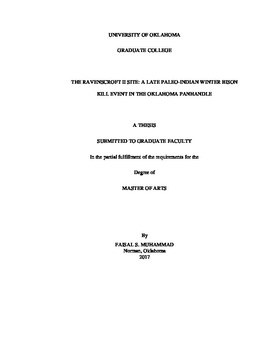| dc.contributor.advisor | Bement, Leland | |
| dc.contributor.author | Muhammad, Faisal | |
| dc.date.accessioned | 2017-05-12T20:53:37Z | |
| dc.date.available | 2017-05-12T20:53:37Z | |
| dc.date.issued | 2017-05-12 | |
| dc.identifier.uri | https://hdl.handle.net/11244/50853 | |
| dc.description.abstract | The winter kill model combines aspects of optimal foraging theory and animal behavioral ecology to explain large scale bison hunting organization on the North American Great Plains. These same theories are applied to the late Paleo-Indian age Ravenscroft bison kill in the Oklahoma Panhandle. The results show the Ravenscroft II site fits the winter kill model. The site is in close proximity to Bull Creek, a tributary of the Cimarron River, which would have provided ample vegetation for bison consumption. Additionally, tooth eruption patterns show wear associated with an 8 month old calf; the calving season spans from March – May with peaks in April. Finally, the herd targeted during the kill event was composed of mature cows carrying fetuses, this is the single greatest indicator of seasonality. | en_US |
| dc.language | en_US | en_US |
| dc.subject | Plains Archaeology, Bison Kill Site, Late Paleo-Indian | en_US |
| dc.title | The Ravenscroft II Site: A Late Paleo-Indian Bison Kill Event in the Oklahoma Panhandle | en_US |
| dc.contributor.committeeMember | Pitblado, Bonnie | |
| dc.contributor.committeeMember | Randall, Asa | |
| dc.date.manuscript | 2017-05-12 | |
| dc.thesis.degree | Master of Arts | en_US |
| ou.group | College of Arts and Sciences::Department of Anthropology | en_US |
| shareok.nativefileaccess | restricted | en_US |
